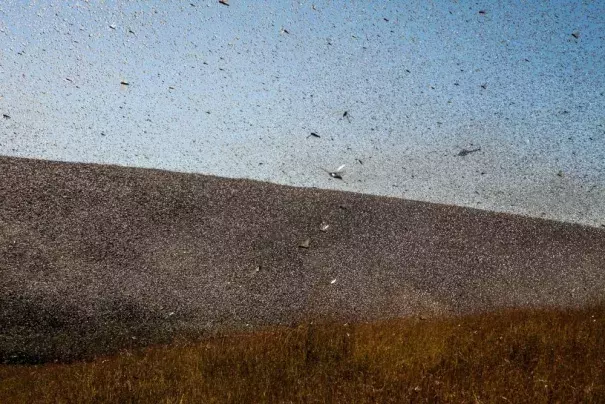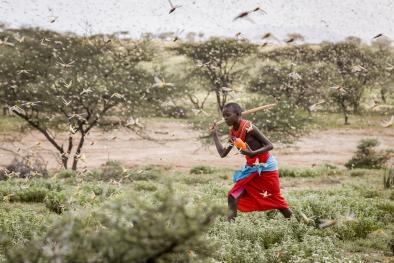Locust Swarms, Some 3 Times the Size of New York City, Are Eating Their Way Across Two Continents

Climate Signals Summary: Climate change is making extreme rainfall more common, like the heavy rains East Africa saw in 2019, which creates perfect breeding conditions for locusts. There is also growing evidence that climate change may be impacting an ocean circulation pattern known as the Indian Ocean Dipole, which can bring more frequent cyclones to the region, like the one that set the stage for the locust crisis.
Article Excerpt: As giant swarms of locusts spread across East Africa, the Arabian Peninsula and the Middle East, devouring crops that feed millions of people, some scientists say global warming is contributing to proliferation of the destructive insects.
The largest locust swarms in more than 50 years have left subsistence farmers helpless to protect their fields and will spread misery throughout the region, said Robert Cheke, a biologist with the University of Greenwich Natural Resources Institute, who has helped lead international efforts to control insect pests in Africa.
"I'm concerned about the scale of devastation and the effect on human livelihoods," Cheke said, adding that he also worried about "the impending famines."
"Despite the coronavirus pandemic, the region needs money and equipment to deploy insect control teams in the affected regions," he said.
...
Changes in plant growth caused by higher carbon dioxide levels, as well as heat waves and tropical cyclones with intense rains, can lead to more prolific and unpredictable locust swarming, making it harder to prevent future outbreaks.
The desert locust (Schistocerca gregaria) needs moist soil to breed. When rains are especially heavy, populations of the usually solitary insects can explode. In Kenya, one of the biggest swarms detected last year was three times the size of New York City, according to a March 12 article in the journal Nature. Swarms a fraction of that size can hold between 4 billion and 8 billion locusts.
...
The changing climate has spurred other insect invasions. Warmer winters, for example, are magnifying an ongoing bark beetle outbreak in western North America. Until the 1980s, periodic cold snaps kept the beetles in check. But since then, the tree-killing bugs have swarmed—not as fast as desert locusts, but just as destructively. Since 2000, they've killed trees across about 150,000 square miles in Canada and the western U.S., an area nearly the size of California. In recent years, historic bark beetle outbreaks have also devastated European forests.
Other research shows that seasonal shifts caused by global warming are disrupting cycles of insect reproduction and plant pollination, including a recently documented decline of bumblebees, threatening food production in some areas.
Global warming is also affecting the feeding and breeding patterns of North America's grasshoppers, species that behave similarly to locusts. In the 1930s, swarms of grasshoppers destroyed crops in the Midwest, even eating wooden farm tools and clothes that were drying outside. States like Colorado used flamethrowers and explosives to battle the insects.
...
Locust outbreaks could be driven by changes in plant nutrients caused by extreme weather, Welti said, like more frequent soggy tropical storms, which make plants grow faster but dilute elements like nitrogen. "Locusts have a weird physiology—they like low nitrogen plants," she said of connections she explored in a recent study published in the Proceedings of the National Academy of Sciences.
But the current locust outbreaks, Welti said, are occurring against the backdrop of an alarming global decline in overall insect abundance, which is also, to some degree, connected to climate change and will have far-reaching ecosystem impacts.
Warm weather and heavy rains at the end of 2019 set up a perfect storm of breeding conditions for the destructive bugs. The outbreak followed an unusually active West Indian Ocean cyclone season with several of the storms bringing extreme rainfall to parts of East Africa.
Studies in the last few years have showed that global warming is boosting the rainfall from tropical storms. Other recent research shows that human-driven warming may be intensifying a regional Indian Ocean pattern of warming and cooling that could exacerbate extremes like tropical storms, heavy rains and heat waves—all factors that can affect locust populations.



